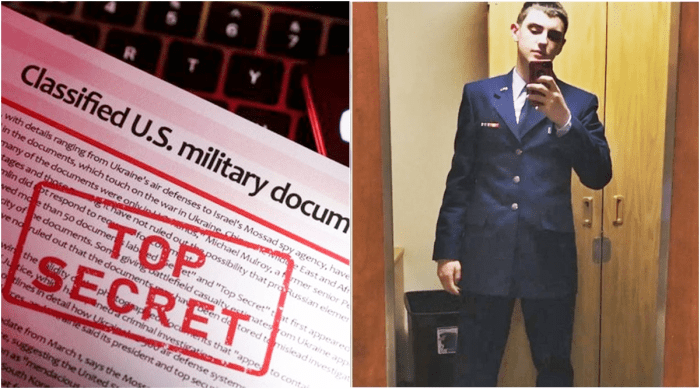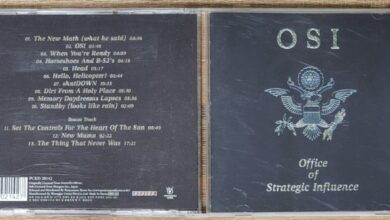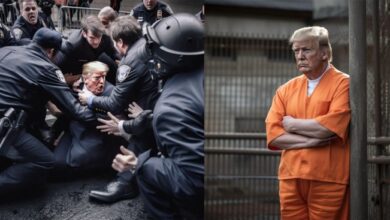
Presidential Power to Declassify Information Explained
Presidential power to declassify information explained sets the stage for this enthralling narrative, offering readers a glimpse into a story that is rich in detail and brimming with originality from the outset. The ability of a President to release classified information is a complex and often controversial issue, touching on the delicate balance between national security and public transparency.
This power, rooted in the Constitution, has evolved over time, shaped by legal precedents and landmark cases, and influenced by the political climate. It’s a power that can shape history, revealing secrets and sparking debates, and understanding its intricacies is crucial for any informed citizen.
This blog delves into the legal framework, historical context, and practical implications of presidential declassification authority. We’ll explore the Executive Order 13526, the role of the National Archives, and the different categories of classified information. We’ll also examine the limits and constraints on this power, the potential consequences of declassification, and the impact it can have on public understanding, transparency, and political discourse.
Presidential Power to Declassify
The President of the United States possesses the power to declassify information, which is a critical aspect of executive authority and national security. This power allows the President to release classified information, making it accessible to the public or specific individuals.
Constitutional Basis for Declassification Power
The President’s power to declassify information stems from the Constitution’s vesting clause, which grants the President the “executive Power.” While the Constitution doesn’t explicitly mention declassification, it’s considered an inherent power derived from the President’s responsibility to manage national security.
The President’s authority to declassify is rooted in the broader power to execute laws, including those related to national security.
Evolution of Declassification Power
The President’s declassification power has evolved over time, influenced by legal precedents and landmark cases.
Key Legal Precedents and Landmark Cases
- The “Nixon Tapes” Case (United States v. Nixon, 1974):This landmark case established the principle of executive privilege, but it also recognized limits on the President’s ability to withhold information from Congress and the courts. The Court ruled that even the President is subject to the law and cannot shield information solely on the basis of executive privilege.
This case highlighted the need for transparency and accountability, even in matters of national security.
- The “Iran-Contra Affair” (1985-1987):This scandal involved the Reagan administration’s secret sale of arms to Iran in exchange for the release of American hostages. The affair led to a significant debate about the President’s power to conduct foreign policy without congressional oversight. The controversy also raised questions about the President’s ability to declassify information related to sensitive foreign policy matters.
It’s fascinating to think about the power presidents hold to declassify information, isn’t it? It’s a responsibility that comes with immense power, but also with the potential for misuse. Speaking of something entirely different, I just read about an injured loggerhead turtle found in Cumbria released into the wild ! It’s a heartwarming story that reminds us of the importance of conservation.
Anyway, back to presidential power, I’m still pondering the complexities of declassification and its impact on national security and public transparency.
- The “Clinton-Lewinsky Scandal” (1998):This scandal involved President Bill Clinton’s attempts to conceal his relationship with Monica Lewinsky. The case highlighted the President’s power to declassify information and the potential for abuse of this power. It also led to the passage of the Presidential Records Act, which established guidelines for the preservation and disclosure of presidential records.
Examples of Presidential Declassification
Past presidents have exercised their declassification power in various ways, ranging from releasing historical documents to declassifying information related to ongoing investigations.
It’s fascinating to see how the president’s power to declassify information plays out in real-world scenarios. While that’s a serious topic, it’s also fun to think about how Dodge is taking on the electric car market with their new crossover, the Hornet.
Whether it’s about classified documents or car designs, the ability to control access to information is always a hot topic.
Examples of Declassification by Past Presidents
- President Harry Truman:Truman declassified information related to the atomic bomb project, aiming to increase public understanding of the Manhattan Project and its implications.
- President John F. Kennedy:Kennedy declassified documents related to the Bay of Pigs invasion, seeking to provide a more complete account of the failed operation.
- President Richard Nixon:Nixon declassified information related to the Watergate scandal, although he initially attempted to withhold this information.
- President Bill Clinton:Clinton declassified documents related to the Whitewater scandal, aiming to address public concerns about his administration’s involvement in the controversy.
- President Barack Obama:Obama declassified information related to the use of torture by the CIA, seeking to provide transparency about the agency’s practices during the War on Terror.
Legal Framework and Regulations

The legal framework governing declassification of information in the United States is a complex interplay of executive orders, statutes, and regulations. These rules establish the procedures and standards for releasing classified information, ensuring a balance between national security and public transparency.
Executive Order 13526
Executive Order 13526, issued by President Barack Obama in 2009, remains the primary legal authority governing the declassification of classified information. This order establishes a comprehensive framework for declassification, emphasizing the presumption of declassification and promoting timely release of information.
“The presumption of declassification is the guiding principle for the management of classified information,”
The President’s power to declassify information is a complex topic, often debated in legal and political circles. Recent events, like the judge denying Lindsey Graham’s appeal to delay testimony before the Georgia grand jury investigating Trump , highlight the potential for this power to be used in ways that impact ongoing investigations.
As the legal landscape surrounding declassification continues to evolve, it will be interesting to see how courts and lawmakers grapple with its implications for transparency and accountability.
This order Artikels the specific procedures for declassification, including the roles of various government agencies and the process for handling requests for declassification.
The Role of the National Archives and Records Administration (NARA)
The National Archives and Records Administration (NARA) plays a crucial role in the declassification process. NARA is responsible for the management of government records, including classified information. It receives declassification requests from the public and other government agencies and makes recommendations on whether to declassify information.NARA also maintains the declassification review process, ensuring that all classified information is reviewed for potential declassification.
It publishes guidelines and regulations on declassification procedures and provides training to government officials on the process.
Categories of Classified Information and Their Declassification Procedures
The United States government classifies information into three categories:
- Top Secret:This category encompasses information that could cause exceptionally grave damage to national security if disclosed. The declassification of top-secret information is subject to strict review and approval processes.
- Secret:This category covers information that could cause serious damage to national security if disclosed.
Declassification of secret information requires a higher level of approval than confidential information.
- Confidential:This category includes information that could cause damage to national security if disclosed. Declassification of confidential information is generally subject to a less rigorous review process than top-secret or secret information.
Each category of classified information has specific declassification procedures, Artikeld in Executive Order 13526 and other relevant regulations. These procedures vary based on the sensitivity of the information and the potential risks associated with its release.
Limits and Constraints

While the President holds significant power to declassify information, it is not absolute. Several legal and ethical constraints limit this authority, ensuring that the national security and public interest are protected.
Legal Constraints
The President’s declassification authority is subject to legal limitations. The Presidential and Federal Records Act (PFRA) of 1978 and the National Security Act of 1947 provide the legal framework for declassification. These laws Artikel the process for declassification and establish specific criteria that must be met.
- Statutory Exemptions:Certain information is exempt from declassification under specific laws. For example, information related to ongoing investigations, classified intelligence sources, or information that could compromise national security is often protected from disclosure.
- Executive Orders:The President can issue executive orders that further define declassification procedures and establish additional criteria for releasing classified information. For example, Executive Order 13526, issued by President Obama in 2009, provides comprehensive guidelines for declassification, including requirements for declassification reviews and the establishment of a declassification review process.
- Judicial Review:The President’s declassification decisions can be challenged in court. Courts have the authority to review these decisions and determine whether they comply with the law and the relevant executive orders. If a court finds that a declassification decision is illegal or violates the law, it can overturn the decision and order the information to remain classified.
Ethical Constraints
Beyond legal constraints, ethical considerations also play a crucial role in presidential declassification decisions.
- Protection of National Security:The President must weigh the potential risks to national security associated with declassifying sensitive information. Declassification could reveal intelligence sources, methods, or vulnerabilities that could be exploited by adversaries, potentially jeopardizing national security.
- Protection of Individuals:Declassification could expose confidential information about individuals, including informants, witnesses, or even innocent civilians. The President must consider the potential harm to individuals and ensure that their privacy is protected.
- Public Interest:The President must balance the public’s right to know with the need to protect sensitive information. Declassification can serve the public interest by promoting transparency and accountability, but it can also have unintended consequences. The President must carefully consider the potential impact of declassification on the public interest.
Consequences of Declassification
Declassifying sensitive information can have significant consequences, including:
- National Security Implications:Declassification can compromise national security by revealing intelligence sources, methods, or vulnerabilities. This could expose the United States to espionage, sabotage, or other threats. For example, declassifying information about a covert operation could jeopardize the operation’s success and expose the individuals involved to danger.
- Damage to International Relations:Declassification can damage relations with foreign allies by revealing sensitive information about intelligence sharing or diplomatic negotiations. This could strain relationships and undermine trust.
- Legal Liability:Declassification can expose the government to legal liability, particularly if it reveals information that could be used in lawsuits or criminal prosecutions. This could lead to financial settlements, reputational damage, or even criminal charges.
Congressional Oversight
Congress plays a critical role in overseeing the President’s declassification authority.
- Congressional Committees:Congressional committees with oversight responsibilities for intelligence, national security, or foreign affairs have the authority to review the President’s declassification decisions. They can hold hearings, request information, and conduct investigations to ensure that declassification decisions are appropriate and comply with the law.
- Legislative Action:Congress can pass laws or amend existing laws to further regulate the President’s declassification authority. For example, Congress could enact legislation to strengthen the declassification process, establish additional criteria for declassification, or increase congressional oversight.
- Legal Challenges:Congress can challenge the President’s declassification decisions in court. This could involve filing lawsuits to overturn a declassification decision or to compel the release of classified information.
Impact and Implications: Presidential Power To Declassify Information Explained
Declassification, while a complex process with various legal and procedural frameworks, ultimately serves a crucial purpose: to shed light on government operations and historical events, promoting transparency and accountability. The impact of declassification extends beyond mere disclosure; it can significantly influence public understanding, policy decisions, and even the course of political discourse.
Impact on Public Understanding
Declassification can significantly enhance public understanding of government operations and historical events. By releasing previously classified information, the public gains access to firsthand accounts, policy deliberations, and intelligence assessments, allowing for a more comprehensive and nuanced understanding of past events.
This access can lead to a more informed public, capable of engaging in critical analysis and debate on crucial issues.For example, the declassification of documents related to the Vietnam War has provided valuable insights into the decision-making process, the complexities of the conflict, and the human cost of war.
This information has not only contributed to a better understanding of the war but has also spurred ongoing debates about its legacy and the lessons learned. Similarly, the declassification of documents related to the Watergate scandal shed light on the abuse of power and the importance of accountability, shaping public discourse and influencing future political reforms.
Case Studies and Examples
The presidential power to declassify information has been exercised in various ways throughout history, resulting in a range of consequences and controversies. Examining specific examples provides valuable insights into the complexities and implications of this power.
Notable Declassification Decisions
This section delves into notable examples of presidential declassification decisions, exploring their motivations and consequences.
- The Pentagon Papers (1971):President Nixon initially sought to prevent the publication of the Pentagon Papers, a classified study detailing the history of U.S. involvement in Vietnam. However, the Supreme Court ruled in favor of the New York Times, allowing the publication of the documents.
This case highlighted the tension between national security and freedom of the press, and it established the principle that the government cannot suppress information simply because it is classified.
- The Iran-Contra Affair (1985-1987):President Reagan’s administration was embroiled in controversy after it was revealed that they had secretly sold arms to Iran in exchange for the release of American hostages. The declassification of documents related to this affair revealed the extent of the administration’s involvement in the illegal arms deal and led to investigations and public hearings.
- The 9/11 Commission Report (2004):The declassification of documents related to the 9/11 attacks played a crucial role in the investigation and subsequent report by the 9/11 Commission. This declassification process provided valuable information about the events leading up to the attacks and helped to shed light on the intelligence failures that contributed to the tragedy.
Controversies Surrounding Declassification
This section analyzes controversies surrounding certain declassification actions, including legal challenges and public debates.
- The Trump Administration’s Declassification Practices:The Trump administration’s approach to declassification was highly controversial, with critics arguing that it was politically motivated and undermined national security. The administration’s actions, including the declassification of documents related to the Mueller investigation, were subject to legal challenges and public scrutiny.
- The Biden Administration’s Declassification Review:The Biden administration has implemented a more cautious approach to declassification, emphasizing the need to balance national security concerns with transparency. This approach has been met with mixed reactions, with some praising its emphasis on due process while others criticize its perceived slow pace.
Comparing Declassification Approaches, Presidential power to declassify information explained
This section compares and contrasts different declassification approaches employed by past presidents.






